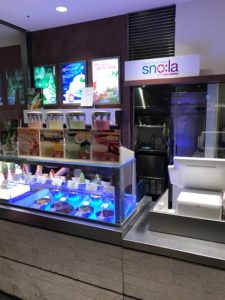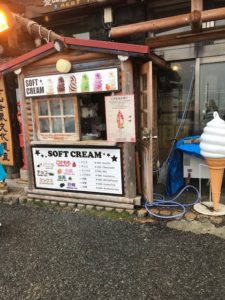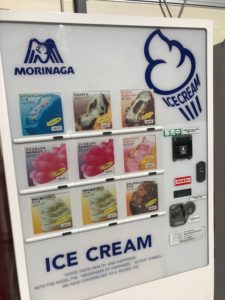
Sno:la in Tokyo
We recently returned from a trip to Japan and were inspired to share what we’ve learned about soft cream and frozen yogurt in Japan. Soft cream, aka soft serve ice cream, is served from a soft serve machine, usually. However, there are also soft cream/soft serve treats in the freezer section of markets and vending machines, in cone and cup form.
History of Soft Cream
Japan’s love affair with soft cream started in the early 1950’s. According to a Saveur article, “soft cream was introduced by American occupying forces on their (American) Independence Day celebration in 1951, and later that year department stores all over the country started serving it.” This was the time period when many American foods were introduced to Japan.
Japan took soft cream and made its own. Many of the flavors are specific to a certain region. For example, if a particular town or region is known for the quality for what they grow or produce, it’s likely that whatever that specialty is will wind up as a soft serve flavor. Unusual flavors include soy sauce, egg, sake, yuba, miso, wasabi, kombu, olives, and scallops. Common flavors include vanilla, chocolate, milk, strawberry, and matcha green tea.
Soft Cream Shops
Soft cream is everywhere, including airports, snack bars inside parks, convenience stores, sweet shops, etc. It’s more popular than gelato and scoopable ice cream. Soft cream might even be the most popular treat in Japan. Cones are more common than cups. Toppings are typically not offered. Soft cream cones are priced at about 350 – 550 yen ($3.19-$5.02 in US dollars).

Typical soft cream stand in Japan
Many shops that serve soft cream have too little physical space to accommodate the self-serve concept. Shops usually have one or two Nissei Freezer heat-pasteurized soft serve machines at the establishment and large plastic soft serve cones. Nissei also supplies soft serve mix but not frozen yogurt mix.
While you can find soft cream all over Japan, Hokkaido is the only area in Japan suitable for large scale dairy farming. Thus, Hokkaido is renowned for dairy products and Hokodate (city in Hokkaido) is famous for soft cream. You’ll find Soft Cream Street in Hokodate City, Hokkaido, a street filled with soft cream vendors.
Frozen Yogurt Shops in Japan, Pre-2010
Enter frozen yogurt. The oldest frozen yogurt shop that’s still open today is Woodberry’s in Tokyo, which is celebrating its 21st year in business this year. Their approach is reminiscent of soft cream vendors. They take seasonal fruit and mix it with their plain organic frozen yogurt base. Each portion is mixed fresh to order. They make their own yogurt base.
Once the new wave of frozen yogurt shops started opening in the US during the mid-to-late 2000s, new frozen yogurt shops opened in Japan as well. Sno:la and Golden Spoon opened in Japan in 2008. Sno:la’s founder is Japanese. The shop emphasizes quality, organic frozen yogurt made with less sugar. It’s still open today in Kyoto and Tokyo (Ginza Mitsukoshi food hall). Golden Spoon, the chain from California, has closed.
Canadian chain and mix-in frozen yogurt specialist, Yogen Fruz, entered the Japanese market before 2008. There are a few locations in Japan still listed on the website. Cold Stone Creamery, the custom blend in ice cream chain, entered the Japanese market around 2005. In 2014, Cold Stone Creamery Japan launched its new yogurt concept. Customers selected mix-ins and frozen yogurt, after which the fruit and yogurt and mixed together using a machine. Cold Stone Creamery Japan recently introduced soft cream.
Frozen Yogurt Shops in Japan, Post-2010
Yogurtland, the California based chain, was the first self-serve frozen yogurt shop in Japan when it opened in 2010 (2011?). Those locations later rebranded as Partyland. More chains entered the Japanese market, including Menchie’s in 2012, Red Mango in 2014, Pinkberry in 2015, and Yogorino in 2016.
Yogorino, the Italian chain, seems to be doing well or at least its been the most aggressive at expanding. The frozen yogurt is imported from Italy. The plain flavor is sweeter than original/plain tart. Yogorino’s emphasis is on quality and simplicity, which seems to resonate well with the Japanese market. And, Italy is known to have the best gelato (Yogorino can be considered as yogurt gelato). Pinkberry, arguably the most iconic name in frozen yogurt, has also had some success, with 7 locations in Japan and a new summer pop-up location in Tokyo (Midtown Hibiya). Both Yogorino and Pinkberry are full-service concepts with a limited selection of flavors.
Mom and pop Japanese frozen yogurt shops also opened, including Lemson’s (self-serve), Sweet Grams in Nagoya, and North Haven (self-serve) in Tokyo. Some of these have an American feel (e.g., Lemson’s and North Haven), while Sweet Grams has a more Japanese aesthetic.
Most of the frozen yogurt shops are in Tokyo. But you can also find them in other large cities like Osaka, Nagoya, and Kyoto. There aren’t many froyo shops though.
Yogurt Factory
We were intrigued to learn about Yasuda Yogurt in Yasuda, Niigata Prefecture. It started as a milk processing association in 1987. Since then, they’ve opened several factories, a factory store, shops, a bakery, and a waffle house restaurant. At some point they started offering frozen yogurt.
Why Frozen Yogurt Hasn’t Achieved Popularity in Japan
Frozen yogurt has yet to achieve the popularity in Japan as it has in the US and other countries, including Asian countries like Singapore. Perhaps it’s because soft cream is so exceptional and widely available. The anti-Korean sentiment could be a factor, though most of the frozen yogurt chains that entered Japan aren’t directly from Korea. However, Pinkberry was started by Korean Americans, Red Mango started in Korea, and Yogurtland’s founder is Korean. Alternatively, a good portion of the Japanese population seems to dislike the tangy/sour plain flavor of real yogurt.
Most frozen yogurt shops in Japan emphasize toppings more than soft cream vendors. Japanese toppings include Ramune jelly, Sakura mochi, and Matcha cookies. The local flavors of frozen yogurt are soft cream flavors you’d find: black sesame, hojicha, yuzu, sakura, sweet potato, etc.

Ice cream vending machine in Japan
Future of Frozen Yogurt in Japan
So, what’s the distinctive appeal of frozen yogurt if it isn’t tangy or tangy flavors aren’t popular? Toppings? Probiotics? The lower fat content of frozen yogurt? Portions in Japan tend to be small, so they might not be as concerned about fat content. Thus, the probiotic angle has more promise. Perhaps someone should make a Bulgarian frozen yogurt, since Bulgarian yogurt has become accepted in Japan because it is perceived as healthful and authentic.
Japan is known for its cutting-edge vending machines, so it seems like a place where frozen yogurt robots would do well. The most common type of vending machine seems to be for beverages but we did see ice cream vending machines with frozen treats from Haagen Dazs, Godiva, and Meiji.
While it’s exciting to see so many soft serve machines in Japan, the majority are heat treated, meaning that shops that want to offer frozen yogurt will need to invest in new machines if they want to keep the probiotics in yogurt alive.
Pictures of Froyo in Japan
We’ve compiled pictures of Japanese frozen yogurt shops on our Pinterest board, Froyo Shops in Japan.




